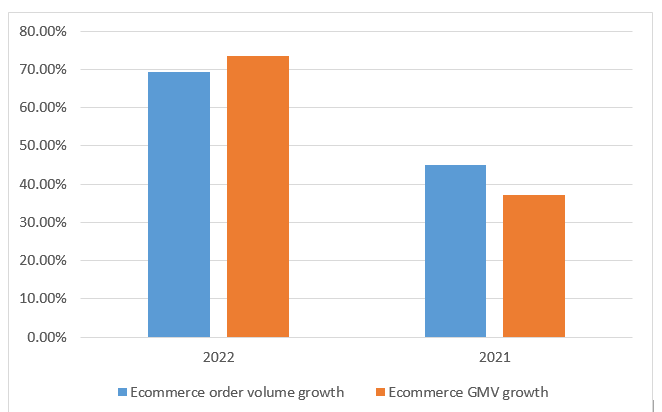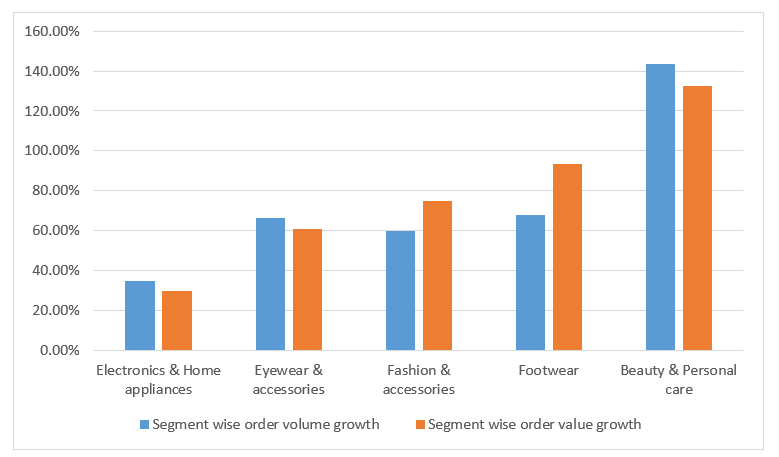Indian e-commerce rise 37% in 2022
Despite the receding COVID-19 fears and shoppers returning to physical stores, the Ecommerce industry reported an impressive growth of 36.8% Y-o-Y in FY 2022. Brand websites showcased stronger growth than marketplaces with 80.4% Y-o-Y growth.
Going forward, Indian retail and e-commerce players are dedicating significant process and technology investments. These ensure faster delivery and optimal shopping experiences. With the continuous rapid growth of Tier 2 and 3 markets, new regions are expected to gain a lot of attention.

Image credit: Pixabay
India observed a sharp growth in e-commerce sales in FY 2022, despite lifting the Covid19 restrictions. E-commerce enabler Unicommerce recently analyzed more than 500 million online transactions. According to their study, 3-tier markets like Roorkee, Rohtak and Udaipur recorded 64.7% Y-o-Y growth in 2022, whereas, 2-tier markets like Bhopal, Amritsar and Bhubaneshwar recorded 50.9% Y-o-Y growth.
Tier-1 markets witnessed order volumes growth of 10.3% YoY during the year. The Tier-2 and 3 cities accounted for 63% of total orders placed by users and recorded a faster growth than Tier-1 markets.
These trends show that e-commerce growth in India has well and truly moved beyond the large cities to hundreds of tier-2, 3 and smaller cities across the length and breadth of the country.
Maharashtra, Delhi/NCR and Karnataka contribute to the largest ecommerce order volumes. Mumbai and Pune contribute the maximum order volume share in Maharashtra.
With reopening of public places and offices post-Covid, traditional e-commerce leader categories like fashion and accessories & footwear demonstrated a remarkable and quick recovery. The beauty and personal care segment has recorded maximum growth of 143% YoY in order volumes and 132% YoY in order value.
Ecommerce Order volume growth vs Ecommerce GMV growth 2021-22

Source: Unicommerce
The fashion accessories and footwear segment showed strong growth in the COVID era, as the consumers were under lockdowns or in WFH environments. After relaxation of COVID-19 restrictions, fashion accessories and footwear reported stronger order volume growth of 59.7% and 67% respectively. As homebound shoppers largely ordered athleisure and comfort wear last year, in 2022, Gross Merchandise Value (GMV) grew by 75.1% YoY for fashion accessories and 93.3% YoY for footwear.
Dominated by spectacles and sunglasses, the eyewear segment grows consistently Y-o-Y with 66% order volume and 60% order value. Items under home décor and furniture, sports equipment, books and stationery also witnessed 75.9% growth in FY22. Interestingly, the electronics and home appliances segment witnessed slower growth with 34.7% YoY order volume growth and 29% order value growth in FY 2022.
As per recent trends, since shoppers are now aware of potential deals and prefer to shop from trusted brands directly, the brand websites showcase stronger growth than marketplaces with 80.4% Y-o-Y growth, whereas, the marketplaces reported 56.6% growth in same period.
The Covid era enabled consumers to access medicines and supplements via ecommerce websites. Continuing the trend, the health and pharmaceutical segment also reported a strong order volume growth of 84.8% on brand websites and 9.2% growth in marketplaces.
Order volume growth vs Order value growth (segment wise 2022)
 Source: Unicommerce
Source: Unicommerce
The electronics segment recorded 38% growth in orders from brand websites and 33.1% from marketplaces. The FMCG and agriculture segment also reported YoY growth of 67.7% through brand websites in 2022. On the other hand, the segment grew by 50.6% in marketplaces.
Bigbasket.com is the leading Indian e-commerce portal with net sales of US$1,222 million in 2021, followed by ajio.com with US$1,119 million. Reliancedigital occupies the third position with revenues of US$752 million. The fourth biggest online store in India is grofers.com with net sales of US$350 million in 2021.
Aiming for India’s digital economy to touch US$ 800 Bn by 2030 and to boost ecommerce infrastructure in underdeveloped and remote areas, the central government has undertaken various steps discussed below:
- Digital Infrastructure: To support rural broadband penetration, the government has introduced the BharatNet program with an outlay of INR ~61,000 Cr. The program aims to deliver broadband connectivity to India’s 2,50,000 Gram Panchayats.
- Digital Payments and Technology: With technologies like UPI, RuPay, DigiLocker and eKYC, the government aims to promote digital transactions in smaller cities. To financially incentivize digital payments, a INR 1,500 Cr scheme was proposed in FY22 budget.
- One District One Product Programme (ODOP): The ODOP programme introduced by the government focuses on selecting, branding and promoting “One product” from each district of the country and enable holistic socioeconomic growth across the states. The programme provides ecosystem for innovation and use of technology at district level to make the local manufacturers competitive with domestic as well as International markets. One such instance is UP, where Uttar Pradesh handicrafts Development & Marketing corporation has set up odopmart.com, under the ODOP programme. The website gives purchase access to locally produced items, district-wise.
In the post-pandemic era, Indian retail and e-commerce players are dedicating significant process and technology investments. These ensure faster delivery and optimal shopping experiences. With continuous rapid growth of Tier 2 and Tier 3 markets, new regions are expected to emerge as priority market for leading marketplaces and online sellers.













Leave a comment